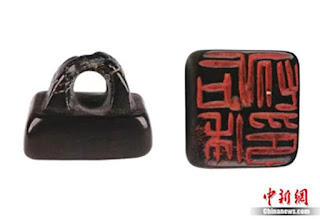ARTICLE AD BOX
Adil Abliz, a researcher of the Museum of the Uyghur Autonomous Region and a member of the 13th Political Council of the Uyghur Autonomous Region, wrote in the December 17th, 2021 issue of the Chinese website sohu.com, "The Four Corners is a small wall, and the army is stationed in agriculture and border defense in 2000. published an article titled "Summary of its long history".
He also repeated some of the contents of the article in an interview with a Xinhua News Agency reporter on May 4 last year, saying, "The discovery of this seal explains that the Eastern Han Dynasty set up a state agency to manage agricultural affairs by stationing special soldiers in Niya." said Later, he further revealed his intention, "The discovery of the seal of the Eastern Han Dynasty in the ruins of Niya with the name of "Court Seal of the Elders" indicates that this place was a military and agricultural area of the Eastern Han Dynasty in those years." said He was not satisfied with these words, but declared that "105 BC was the time when agriculture began with the formation of soldiers."
It is not clear on what evidence and reason Adil Ablis came to such a conclusion. We don't need to inquire separately because we know that life's ambitions or high ambitions are telling him not to be like that. However, we believe that it is useful to look at some of the important events that happened in the years that he mentioned, so that those interested in the details of the event can distinguish between the true and the false.
In 141 BC, Han Wu, who took the throne of the Han Dynasty, reformed the strategy of war against the Huns. He first sent Zhang Qian and other envoys, princesses, and other rich gifts to the Hun allies or vassals, such as the great barbarians and Uisuns, to persuade them to cooperate with him in fighting against the Huns. On the other hand, God created disagreements between Hunquti and his relatives, which led to conflicts within the Hun Empire. The Hun army suffered many defeats due to the defections of some members of the Tiyarqut family to the Han side and some of their number defecting to the enemy with the majority of their troops.
As a result, in 119 BC, the Huns temporarily retreated to the north, abandoning the land inhabited by the West Village, Uisun, and the great beasts. Thus, a "non-camp" situation was formed in the south of the present-day Mongolian desert.
The Han Dynasty knew that its long-awaited opportunity had arrived, and employed other tactics to "separate the Huns from their right hand," in the words of Han Wu, that is, to separate the Huns from their nests. In 105 BC, he sent a princess to Uisun Khan with several hundred people under the pretext of courtship. As Uysun Khan did not respond immediately, Han envoys waited for months for his reply. There is no record of them farming during this wait.
Recently, Chinese historians have exaggerated the stories of the dull Heraultan established in the land of the Huns who had been left out of possession as described above, or the military establishment that lasted only a few years, and they call that the time when the Chinese began to rule the western land. Originally, they said that they established the first "Dukhufu", that is, the "Western Land of Kurukchibeg Court", which was razed to the ground by the Kusen Dynasty in 75 AD before a year had passed. They should not forget the rest.
According to Chinese historical records, farmers in the frontier areas were made up of three types of people: soldiers, civilians, and criminals. These three types of people were actually the same group of people praised by different people.
In "Later Hannameh", Volume 1, page 200, there are the following sentences that identify those people: "In the same year (101), Li Guangli, the ruler of Sutrishana, marched to Fergana to defend the border areas under the orders of Han Wu. ".
In "Later Hannameh", Volume 1, page 121: "In September of the same year, Han Mingdi: All criminals sentenced to death by the provinces, districts, and the capital will be reduced to one level from the death penalty. They will not be tortured, they will be drafted and given the opportunity to work. Holds Shufang and Dunhuang provinces; If he wants to take his wife and children with him, they will be allowed to go too. But the exiled daughters will not go, he lamented.
It is also stated on page 121 of the same book: "On September 24, 74 AD, in Wuwei, Zhangye, Jiayuguan, Dunhuang Provinces and Zhangye Garam El, criminals who had their right toes amputated but were still fit for military service were not punished, and they were recruited into the army." "We must," he said.
Similar statements are common in Chinese historical sources. The provinces and Karam al mentioned here were originally the lands owned by the Han, and were the provinces and counties built on the lands conquered by the Han Dynasty in those years. Some of the people who lived there were criminals who had been forcibly relocated from the inner provinces of the Han, and people who had been captured and/or surrendered from other tribes. It was clearly a fraud to announce that these people had been sentenced to death and then to be freed from death by the Khan. Deluded criminals and captives were ready to do anything to show their gratitude. Their family members were naturally enslaved by the Han Dynasty and subjected to hard labor.
"Later Hannamese Gems" and "Later Hannamese. It is stated that the above-mentioned five cities were established during the Han Wu period and that the Huns who were all were settled in these cities.
In other words, the Hexi Corridor and Duntian (屯田) in the Han Dynasty were nothing more than penal camps set up on the territory of the Huns for the purpose of physically torturing them mentally and eventually assimilating them.
Such penal camps were also established after the Huns for their descendants, the Turks. In 640, after the Tang raiders invaded Turpan, they started in Turpan, Hamul, and Jimusar, and then continued to expand to other cities such as Karamurang, Kucha, and Bugur. In places with abundant water, fertile soil and beautiful scenery, the local people were driven out and agricultural areas were built with cities as the center. But this time too, it didn't last long.
In each of the so-called punitive marches, China had to find a way to solve the problem of not having enough food looted from the people in the colonized lands for a large number of soldiers and horses. The cities they attacked were well defended, and if they could hold out for a few days the starving invaders would be forced to retreat.
Many years later, in 1755, the Manqing government sent a large army to invade East Turkistan together with the Oirats. At first, he massacred the local people at will. After that, he planted his soldiers in the fertile lands in the north of the Uyghur region. Dispersed the local Uyghurs in the city and created the "Flag of Muslim Waste Land Development". In the south, following the big and small lords, they exiled some of the inhabitants of the Seven Cities to the north, and after the Manchu, Chinese, and Oirat flags, created the "criminal Muslim flag of the barren land" and used them as slaves. Since then, the Manchu word "Taranchi" which means "picker" has been used as a name for Uighurs. The workforce was divided into ordinary Chinese soldiers, Manchu Imperial forces divided into eight banners, local people, and criminals.
During the Manqing Dynasty, Lin Zeshu, who was exiled from the Chinese from Guangzhou to Ili in the 1840s, and Zhou Zongtang, the executioner who invaded Uyghur in 1876, played important roles in military cultivation. From 1844 to 1846, the first Uyghur army traveled all over Eli and prepared a plan on where to open wasteland.
In 1949, a unit of the Chinese Communist Army, which invaded Uyghur under false promises, changed its name to the Agricultural Wasteland Reclamation Unit of the Chinese Liberation Army in the early 1950s and called itself the "Bingeon". The Chinese government recruited female convicts and other young women from provincial prisons in Shanghai, Shandong, Gansu and Shaanxi to settle the occupying soldiers from mainland China safely and permanently in Uyghur.
It is said that the number of such women exceeded 100,000 by 1958. The Chinese government also confused the East Turkistan National Army and changed its original name to the 5th Corps of the Chinese People's Liberation Army. Then the army was distributed and part of the soldiers were added to the Chinese army. Therefore, the majority of the soldiers of the so-called Liberation Army were sent to East Turkistan under the name of "army soldiers". On the other hand, population transfer steps were accelerated under the pretext of "army". Today, the population of the "Army" has reached three and a half million, and the Chinese Communist Party, the Chinese government, the military, and entrepreneurs have become an organization that is politically oppressive, economically looting, culturally destructive, and cruelly suppressing Uyghur protests and protests.
In short, the "army" of today is the same as "Tuntian" of that time. First used against the Huns, later against the Turks, the descendants of the Huns, and later against the Uyghurs, the essence of this institution is that it is a sign of occupation and violence as well as aggression and colonialism.
.png)
 8 months ago
4
8 months ago
4









 English (US)
English (US)